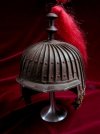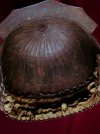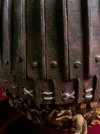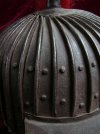- Joined
- Mar 26, 2002
- Messages
- 1,861
I mentioned earlier that I often buy from dealers. Here is another example of why this is a good idea. What you see here is a good example of an early Tibetan / Chinese helmet. Probably Chinese.
I network with several people I consider experts, collectors, museum curators, etc. A good friend and expert in Chinese arms and armor (armour) saw this helmet in a Chinese bazaar in Bejing.
Even though the plume is obviously new, He got very excited. An authentic helmet like this would sell for $30,000 in a London Gallery. It was much cheaper there in Bejing.
The patina looked right, the shape and style also.
Heart pounding, He ran to it and grabbed it, asking the shopkeeper the price. $1,000 USD. CHEAP!
But as he picked it up, he noticed two things. First, though of substantial metal, it was a little too light. Second if you look carefully at the holes where the strapping holds on the plates, you will see that they are round. These holes were made by a drill.
While mechanical drills were used in later periods, this type of helmet should have punched holes. If you look carefully, you can see this even though they tried to make it look punched. A subtle difference, but very well done. Would have fooled me, but not him.
Fake! Repro! Rip-Off!
As he was leaving the shop, he noticed a guy in back with a small truck full of these. He went back in and after a lot of haggling (he speaks fluent chinese), he bought this one for $100. I paid him $200.
It is a good fake.
I have had a few friends see it in my collection and get very excited until I told them the story.
Its a good story.
I know a little about Chinese warfare history, for instance these (real) helmets were made before firearms were in widespread use. A good, solid helmet would stop or deflect a lot of enemy weapons.
BUT it would not stop a bullet. Very few, if any, would. When firearms became popular, the soldiers still wanted helmets. Since heavy, thick helmets would not stop a bullet anyway, and they were more expensive to make, the Chinese army began supplyiing lighter weight helmets to the troopers. In the 1800's they began issuing cloth hats.
Anyhow my point is that there are good enough fakes out there (particulalry in China) that a world class expert could be momentarily fooled.
So I buy from dealers who know their specialty. Chinese from this guy. Javanese keris from this other guy. Etc. I like to deal with people who know their product and also do have a return policy if it EVER can be proved that the piece was not authentic!
And when I travel to foreign lands and a taxi driver has a friend who has a rare blade that once belonged to a local emporer, I look, but rarely buy anything expensive.
I have a few quality pieces that were cheap enough and the story was good enough that it seemed a bargain. This helmet is one of those pieces.
I think it only makes common sense that most people in dirt-poor 3rd world countries have sold anything of great value a long time ago. There are always a rich upper class that have fine objects, but they rarely sell them.
So I let the experts find the really good pieces and sell them to me. It seems smart to have the advice of people who have spent their lives studying a certain area -- and listen to them!
I network with several people I consider experts, collectors, museum curators, etc. A good friend and expert in Chinese arms and armor (armour) saw this helmet in a Chinese bazaar in Bejing.
Even though the plume is obviously new, He got very excited. An authentic helmet like this would sell for $30,000 in a London Gallery. It was much cheaper there in Bejing.
The patina looked right, the shape and style also.
Heart pounding, He ran to it and grabbed it, asking the shopkeeper the price. $1,000 USD. CHEAP!
But as he picked it up, he noticed two things. First, though of substantial metal, it was a little too light. Second if you look carefully at the holes where the strapping holds on the plates, you will see that they are round. These holes were made by a drill.
While mechanical drills were used in later periods, this type of helmet should have punched holes. If you look carefully, you can see this even though they tried to make it look punched. A subtle difference, but very well done. Would have fooled me, but not him.
Fake! Repro! Rip-Off!
As he was leaving the shop, he noticed a guy in back with a small truck full of these. He went back in and after a lot of haggling (he speaks fluent chinese), he bought this one for $100. I paid him $200.
It is a good fake.
I have had a few friends see it in my collection and get very excited until I told them the story.
Its a good story.
I know a little about Chinese warfare history, for instance these (real) helmets were made before firearms were in widespread use. A good, solid helmet would stop or deflect a lot of enemy weapons.
BUT it would not stop a bullet. Very few, if any, would. When firearms became popular, the soldiers still wanted helmets. Since heavy, thick helmets would not stop a bullet anyway, and they were more expensive to make, the Chinese army began supplyiing lighter weight helmets to the troopers. In the 1800's they began issuing cloth hats.
Anyhow my point is that there are good enough fakes out there (particulalry in China) that a world class expert could be momentarily fooled.
So I buy from dealers who know their specialty. Chinese from this guy. Javanese keris from this other guy. Etc. I like to deal with people who know their product and also do have a return policy if it EVER can be proved that the piece was not authentic!
And when I travel to foreign lands and a taxi driver has a friend who has a rare blade that once belonged to a local emporer, I look, but rarely buy anything expensive.
I have a few quality pieces that were cheap enough and the story was good enough that it seemed a bargain. This helmet is one of those pieces.
I think it only makes common sense that most people in dirt-poor 3rd world countries have sold anything of great value a long time ago. There are always a rich upper class that have fine objects, but they rarely sell them.
So I let the experts find the really good pieces and sell them to me. It seems smart to have the advice of people who have spent their lives studying a certain area -- and listen to them!





